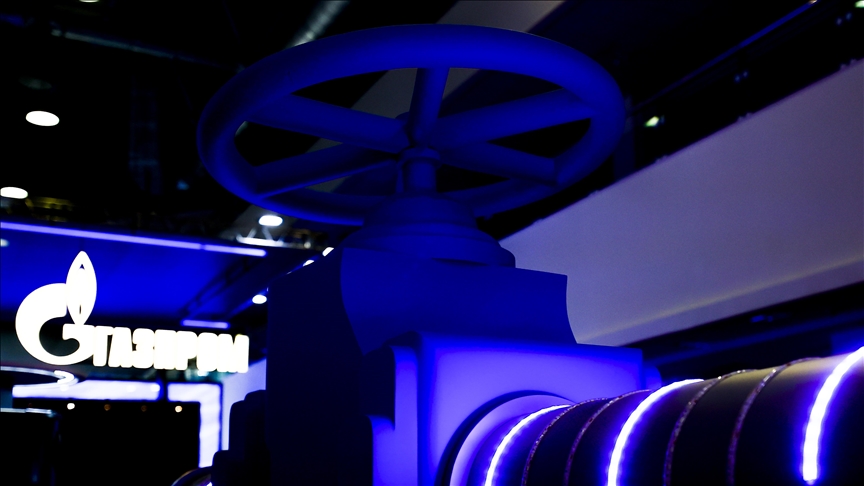All eyes turn to Russia's share of EU's gas imports
Russia, biggest exporter to Europe, accounts for around 45% of EU’s gas imports and almost 40% of gas consumption, according to IEA data
 ( Sefa Karacan - Anadolu Agency )
( Sefa Karacan - Anadolu Agency )
ISTANBUL
After the reduction in gas shipments through the Nord Stream gas 1 pipeline that transmits Russian gas to Europe, markets are now fixated on Russia's share of natural gas imports to European Union (EU) countries.
Russian energy giant, Gazprom, said Monday the reduction in natural gas flow through Nord Stream 1, one of the most important lines for the transmission of Russian gas to Europe, was due to maintenance on a Siemens turbine engine at the Portovaya compressor station, which is essential for the transfer of Russian gas to Europe via Germany.
The company confirmed that exports via the pipeline that transmits 167 million cubic meters of gas per day would be cut from the 40% range last week to 20% due to turbine problems.
Gazprom reduced natural gas shipments via the Nord Stream by 60% on June 15, citing the non-return of the Siemens turbine to Russia following maintenance in Canada.
The Nord Stream has been running well below capacity for weeks and was completely shut down for a 10-day maintenance break earlier this month.
Gazprom had resumed gas flows via Nord Stream 1 last week but only at 40% of its capacity.
EU imports hit 155 billion cubic meters of gas from Russia in 2021
The EU imported 155 billion cubic meters of natural gas in 2021 from Russia, including liquefied natural gas (LNG).
Russia is the biggest gas exporter to the continent, accounting for around 45% of the EU’s gas imports and almost 40% of its total gas consumption, data from the International Energy Agency shows.
Bruegel data reveals that the most heavily dependent countries on Russian gas are Estonia, Finland and Bulgaria, which received 100% of their supply from Russian imports last year.
Other nations with significant dependence include Latvia with 97.5%, Slovakia with 86.1%, Poland with 81.3%, Austria with 80.2%, Slovenia with 79.5%, Hungary with 78% and Lithuania with 68.9%.
Of the union superpowers, Germany and Italy are the most highly dependent on Russian supplies with import shares of 53.7% and 33.4%, respectively, compared to France with a mere 7.6%.
At the end of last year, the share of Czechia’s gas imports from Russia amounted to 53.5%, 34.8% for Denmark, 30% for Romania, 27.8% for Croatia, 18.9% for Greece, Luxembourg totaled 13.8%, the Netherlands held a 5.2% share and Belgium held just 3.5%.
Russia accounted for only 0.5% and 0.1% of the gas imports of Spain and Ireland, respectively.
Bulgaria, Poland, Finland, Denmark and Netherlands cut off from Russian gas
Over the past months, Moscow has cut off gas supplies to several EU member states due to their refusal to pay for Russian gas imports in rubles.
On April 27, Poland and Bulgaria became the first EU countries to be cut off from Russian gas.
Similarly, Gazprom stopped natural gas supplies to Finland on May 20, and in the following days, supplies to Denmark and the Netherlands were cut off.
Energy-saving measures on agenda
Aiming to reduce its dependence on Russian gas by two-thirds by the end of the year, the EU plans to increase its LNG purchases and gas supplies from other source countries like Norway, Algeria and Azerbaijan.
The EU, as part of its emergency energy plan, had agreed Tuesday to reduce gas consumption by 15% to alleviate the risk of having reductions or a complete halt to supplies via the Nord Stream 1 from Russia to Europe.
According to the European Commission, gas supply in 12 EU member states has already been hit by a partial or total cut in retaliation from Russia for the bloc’s sanctions on the country.
The EU has slapped six sets of sanctions on Russia since the start of the war on Ukraine on Feb. 24.
Germany, one of the superpowers of the 27-nation regional block, on July 22 announced a new sharp target of 95% full gas storage by Nov. 1.
Germany is currently at the second stage of its emergency gas plan and there is a potential risk of stepping into the third stage for the first time in its history, according to Karolina Siemieniuk, an analyst at Rystad Energy.
“This would mean that gas supply is no longer sufficient to meet demand, so non-market-based measures may need to be taken to ensure supply to critical customers, Siemieniuk said in a Rystad note.
“We may see rationing of gas supplies, with the reduction occurring first in the industry, with households and critical institutions receiving available gas. Many German cities are already implementing or considering energy-saving measures,” she said.








